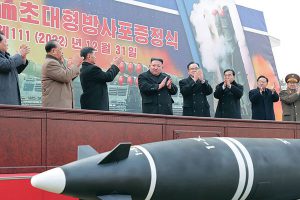Bloomberg
North Korea’s Foreign Ministry said the door remains shut for talks with the US on winding down its atomic arsenal, setting the stage for renewed provocations by pledging to respond to what it saw as threats from Washington.
“The DPRK is not interested in any contact or dialogue with the US as long as it pursues its hostile policy and confrontational line,†the official Korean Central News Agency reported Thursday, citing a ministry spokesperson as saying and referring to the country by its formal name.
Statements from the ministry are among North Korea’s highest form of communication with the outside world. The last time one came out in December, Pyongyang test-launched two short-range ballistic missiles about a day later. The comments from the spokesman come in the wake of a visit by US Defense Secretary Lloyd Austin to meet his counterpart in South Korea, where the nations announced plans to expand joint drills.
“The military and political situation on the Korean Peninsula and in the region has reached an extreme red-line due to the reckless military confrontational maneuvers and hostile acts of the US and its vassal forces,†KCNA cited the spokesperson it did not identify as saying. “The more dangerous the US threat to the DPRK gets, the stronger backfire the US will face in direct proportion to it.â€
After firing off a record number of ballistic missiles last year, Kim Jong Un’s regime has been relatively quiet to start 2023, testing one ballistic missile on Jan. 1 just hours into the new year. The state has two major events on its calendar this month that might be used to coincide with a show of force — the Feb. 8 anniversary of the foundation of the army and its Feb. 16 Day of the Shining Star to mark the birthday of deceased leader Kim Jong Il.
The US and South Korea staged a joint air exercise Wednesday that included a B-1B strategic bomber, and F-22 and F-35B stealth fighters, the Defense Ministry in Seoul said.
“The drills were to show US’s will and capabilities to provide strong and credible extended deterrence against North Korea’s nuclear and missile threats,†the ministry said in a statement.
The US defense secretary said joint drills would continue. “I would simply say that our goal is and always has been to promote greater security and stability throughout the region,†Austin said Thursday during a visit to the Philippines.
South Korean President Yoon Suk Yeol, who took office in May, brought back joint military exercises with his country’s US ally. The drills had been scaled down or halted under former President Donald Trump, who was hoping the move would facilitate his nuclear negotiations with the North Korean leader.
Trump’s three meetings with Kim Jong Un from 2018 led to no concrete steps to wind down Pyongyang’s nuclear program, which only grew in strength and size as the in-person diplomacy eventually fizzled.
The US and South Korea plan to hold tabletop exercises this month that will include plans to look at responses to a North Korea nuclear attack. One of their biggest joint drills may take place in the coming months in the Key Resolve/Foal Eagle exercises, which had often been held in the spring until they were halted under Trump. The drills have involved military training on land, sea and air by US and South Korean military personnel.
South Korea also plans to test a new “high-power†ballistic missile this week that is designed to hit targets in North Korea, Yonhap News Agency reported, citing a source it did not identify. Pyongyang has often responded to such tests by its neighbor by firing off missiles of its own.
 The Gulf Time Newspaper One of the finest business newspapers in the UAE brought to you by our professional writers and editors.
The Gulf Time Newspaper One of the finest business newspapers in the UAE brought to you by our professional writers and editors.
